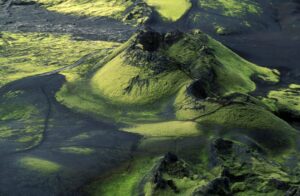The eruption continued in the village of Paricutin, about two hundred miles west of Mexico City, and its cone reached a height of more than a thousand feet in its first year of life.
On February 19, 1943, Dionisio Pulido, a farmer who lived in the village of Paricutin, was about to set fire to a pile of branches he had collected when he noticed for the first time a hole in the ground about eighteen inches deep. A few moments later he heard a noise like thunder and, at the same time, saw that the hole in the ground was pouring out smoke and ashes.
Within a very short period of time he noticed that the ground had risen several feet and there was a continuous hissing sound and a smell of sulfur. He ran to the village priest and together they returned to the hole in the ground. By that time the hole was thirty feet deep and smoke was pouring out of it in large quantities. Fourteen months later the hole had grown and was now a mound that stood twelve hundred feet high and showed no sign of slowing down.
At times, as in February 1952, nine years later, windows of buildings fifteen miles away were being shattered by explosions and earthquakes from the volcano and there were fresh outbursts of lava two hundred yards wide and up to five feet deep. Long before this date, Pulido had left Paricutin and found a job in California, still wondering if he could make some money from his unique status of being the only person in the world who owned a volcano.
Paricutin, located two hundred miles west of Mexico City on the high plains of Mexico, is of much more than local interest. It is the first volcano to come under close scrutiny by scientists from its beginning, a rare event in the history of volcanoes. This only happens, on average, once in 10,000 years. All other volcanic eruptions are built on former volcanoes and their activities are our single direct contact with the inside of the earth. They come up from below through the thirty-mile-thick outer crust of the earth that insulates life from the high temperatures of the molten mass beneath.
When the volcano first appeared, on that day in 1943, local people blamed it on a dispute that had erupted between two communities in the course of which a holy cross had been destroyed. Others attributed it to an earlier plague of locusts. Statements like these have always been a feature of unexpected and poorly understood natural events.
For nine years’ scientists carefully monitored the evolution of Paricutin, seeing quantities of pyroclastics and lava diminish from an initial output of four thousand tons daily to less than three hundred in 1951. Occasionally, throughout that time, there were violent explosions and bursts of rock and lava. At the end of that time, six thousand acres of land had been buried in lava. All of that lava plus, an additional 70,000 acres were covered with a foot of ash. The village of Paricutin, four miles from the volcano, was completely destroyed and its more than seven hundred residents had to move away from the area.
Federal authorities provided new land for them twenty miles away toward the southwest. All of the land that had been covered with lava or ash became useless for any form of agriculture. The human, animal, and botanical life was profoundly impacted in different ways. The records of these differential impacts on all forms of life and on human activities provide the only documentation ever obtained on the immediate effects of volcanic eruptions.
Four and a half thousand cattle and over five hundred horses died as a result of breathing volcanic ash. These animals were the basic resources for survival among the farmers. Humans too experienced some discomfort from the ash as all vegetation and food crops were destroyed. Mice and other small animals died off and so did some insect populations.
The predator of one cane-boring insect did not survive and so the sugar cane crop was lost. In addition to the general destruction of the one farming community there were unexpected consequences in neighboring communities. Paricutin’s volcano is on the higher ground of the plateau so, as summer rains arrived, ash-laded mud flows were carried to lower levels where they ruined dams and silted agricultural areas. As the years passed and the volcano ceased activity, plant and animal life began to reappear in and around the village of Paricutin. The lava fields remained useless for agriculture but the lands that had only ash began, in places, to be productive.
Some entrepreneurs discovered an economic value for volcanic rocks and these were mined for the construction industry. Gradually, as more and more of the former tenants or owners came back, tensions built up over ownership of particular areas as the old boundary marks had gone. By the 1970s there were social pressures for change. The old pattern of settlement could not be reinstated because new people had come to take the place of those who had gone elsewhere permanently.
The general trend of change was toward greater interaction with the larger Mexican society and the loss of old Indian traditions. In Paracutin, nevertheless, it was possible to retain the old traditions, even the old language, because it was now a famous tourist center where people could come and see things as they were when the volcano Paricutin was born.





















